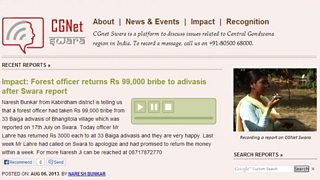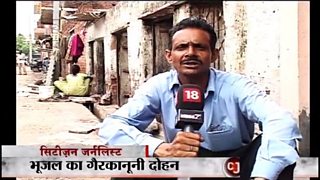Citizen journalism: in pursuit of accountability in India
Parul Agrawal
Multimedia Producer, �������� Hindi Service
Tagged with:
In July this year, in a remote area of the central Indian state of Chattisgarh, a local farmer called Naresh Bunkar did something every one of us does every day: he made a phone call. But this was a call that had remarkable results.
Naresh is a citizen journalist for a voice-based, rural community news portal called . (Swara' means 'voice' in Hindi and Central Gondwana is the area in which the portal works.)
Naresh was phoning the portal that day to record an of how a forestry officer had extorted a bribe of Rs 99000 (approximately £91) from the Advisasi tribal community. Under Indian law, the Advisasi's rights to their land are protected; the officer had 'sold' them deeds to land which they were legally entitled.
Naresh's story was no different to thousands of instances of corruption reported in the local, regional and national press in India. But what followed is different.
Soon after Naresh recorded his report on the site, not only did the officer himself start receiving calls related to the charge, but an official enquiry was instigated. Within a month, the officer was found guilty and the bribe money was returned.

How CGNet Swara reported the successful result of Naresh's report.
Citizen Journalism is a big story everywhere in the world. But my research as a �������� Media
Action Fellow at the highlighted that citizen journalism is developing a different structure in India.
Unlike in the West, where it has been primarily web based and technology driven, in India it has its roots in the lack of an effective mechanism for redressing the grievances of ordinary citizens.
The tools of the internet and new media are still to reach the poor majority in India, who usually lack the necessary resources to express their interests and seek accountability. In a country of 1.2 billion people, India has only 130 million internet users, with even more limited internet penetration in rural India.
In such a context, therefore, it is not surprising that the two most successful citizen journalism initiatives in India have evolved as collaborations between citizen journalists with professional reporters and mainstream media.
Sustainable model
Many organisations have laid claim to being the first citizen journalism initiative in India, including and the Indian chapter of the global citizen media initiative, .
But few have managed to survive commercially and sustain editorial independence. A few community radio, video and mobile reporting initiatives largely financed by non-government organisations have managed to maintain a presence, but they lack active involvement from citizens.
CGNet Swara, in contrast, has emerged as one of the most successful, provocative and self-sustaining of them all.
Anybody from anywhere can dial in to a central server that not just records stories from the ground but also plays back recorded, moderated and filtered content. Contact information for the authorities or other people responsible for solving the problem is also provided so that the site’s users can take direct action and demand an answer.
The service is supported by The United Nations Democracy Fund and International Center for Journalists and was founded in 2010 by former �������� producer and reporter . Since then, the portal has published more than 1000 audio reports, many of which have been picked up by the mainstream media which hasn’t ignored the potential of a new source of stories.
Collaboration with mass media
, for example, is a half-hour TV programme broadcast on one of the national news channels CNN-IBN. The show broadcasts stories from citizens who want an issue investigated to bring about a positive change in their local community or wider society.
One such story featured Brajesh Kumar Chauhan who lives in Delhi and turned citizen journalist for the CJ show to report the lack of water and illegal selling of drinking water in his district, an unauthorised slum area in the sprawling city.
He recorded interviews with his neighbours on a small camera and took pictures of the contaminated water supply. With support from the channel, his story was broadcast on CNN-IBN and he called for a response from the authorities.��

Brajesh Kumar Chauhan reporting about the water issues in his area for CNN-IBN.
Not every story reported through such citizen journalism initiatives leads to such direct positive change.���� And reports of corruption show no sign of abating. But what’s encouraging is that neither does the determination of people like Naresh and Brajesh to get their voices heard.��
To find out more about citizen journalism in India, read Parul’s complete fellowship paper ‘’ and a summary of�� her research findings in , a Reuters Institute for the Study of Journalism publication on the media landscape of today’s India.��
��
Related links
Follow �������� Media Action on and
